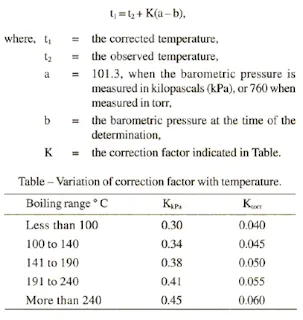The boiling or distilling range of a liquid is the temperature interval, corrected for a pressure of 101.3 kPa within which the liquid, or a specified fraction of the liquid, distills under the conditions specified in the test. The lower limit of the range is the temperature indicated by the thermometer when the first drop of condensate leaves the tip of the condenser, and the upper limit is the temperature at which the last drop evaporates from the lowest point in the distillation flask; it may also be the temperature observed when the proportion specified in the individual monograph has been collected.
Record the temperature at which the first drop of distillate falls into the receiver and adjust the rate of heating to obtain a regular distillation rate of 4 to 5 ml per minute. Record the temperature when the last drop of liquid evaporates from the lowest point in the distillation flask or when the specified percentage has distilled over. Correct the observed temperature readings for any variation in the barometric pressure from the normal (101.3 kPa) using the following expression.
Apparatus
Use an apparatus consisting of the following: Distilling flask. A round-bottomed distilling flask of 200-ml capacity and having a total length of 17 to 19 cm and an inside neck diameter of 20 to 22 mm. Attached about midway on the neck, approximately 12 cm from the bottom of the flask, is a side-arm 10 to 12 cm long and 5mm in internal diameter which is at an angle on oo to 75° with the lower portion of the neck.Condenser
A straight glass condenser 55 to 60 cm long with a water-jacket about 40 cm long or any other type of condenser having equivalent condensing capacity. The lower end of the condenser may be bent to provide a delivery tube, or it may be connected to a bent adaptor that serves as a delivery tube.Receiver
A 100-ml cylinder graduated in 1-ml sub-divisions.Thermometer
An accurately standardised, partial immersion thermometer having the smallest practical sub-divisions (not greater than 0.2° ). When placed in position, the stem is located in the centre of the neck and the top of the bulb is just below the bottom of the outlet to the side arm.Method
If the liquid under examination distils below 80°, cool it to between 10° and 15° before measuring the sample for distillation. Assemble the apparatus and place in the flask 100 ml of the liquid being examined, taking care not to allow any of the liquid to enter the side-arm. Insert the thermometer and shield the entire heating and flask assembly from external air currents. Add a few pieces of porous material and heat rapidly to boiling using a Bunsen burner (or an electric heater or mantle with arrangement for adjustment of the applied heat) and an asbestos plate pierced by a hole 33 mm in diameter.Record the temperature at which the first drop of distillate falls into the receiver and adjust the rate of heating to obtain a regular distillation rate of 4 to 5 ml per minute. Record the temperature when the last drop of liquid evaporates from the lowest point in the distillation flask or when the specified percentage has distilled over. Correct the observed temperature readings for any variation in the barometric pressure from the normal (101.3 kPa) using the following expression.




No comments:
Post a Comment
Please don't spam. Comments having links would not be published.